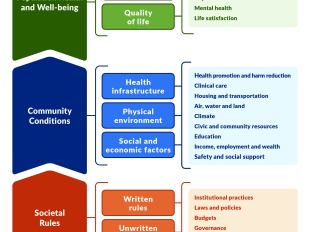About the Rural Health Curated Strategy List

This list features evidence-informed programs, policies, and systems changes that can strengthen educational and workforce opportunities, increase desired features of infrastructure and the built environment, ensure health services are accessible in community-based settings, and protect environmental resources. Rural communities are complex and unique; while this list does not include all possible solutions, it supports ongoing work to advance rural health and well-being.
The WWFH team of analysts developed the list through conversations with local public health professionals, reviewing research literature, and engaging with experts in the rural health space.
What defines rural?
Rural places do not have a single definition or identity. The term ‘rural’ can include geographically isolated areas, tribal lands, small communities or towns, and more.1 There is a complex rural-urban continuum in the U.S. and many residents acknowledge that their communities may not fit a rural-urban dichotomy.6 Communities within a region possess unique assets as well as complex economic and cultural connections to each other that can influence local power to change social, economic, and environmental conditions.7
Whether or not a community is defined as rural impacts how community conditions and health outcomes are measured and understood, as well as resource allocation.6, 8 Some definitions of rural use population or housing unit density, but the purposes and classification systems vary. As a result, some of the differences in health among rural and urban places are due to longstanding policy, practice, norms and traditions that impact whether and how resources are allocated. Ultimately, the definition should fit the application.6 Experts suggest federal agencies create a single rural definition which accounts for variability, to strengthen a rural public health constituency, advance a national rural public health agenda, and increase resources for rural health departments.2 See our health data measure, % Rural, or compare counties with similar rurality.
How can rural communities advance their priorities for health and well-being?
Rural communities can advance their priorities for health and well-being in a variety of ways. The themes below represent some key areas that shape rural health.
Local leadership. Rural communities can define their priorities and identify solutions, which will vary by locality, state, and region and will evolve as community demographics change.9 Rural development practitioners emphasize that initiatives should be locally driven and involve a range of community members and leaders in their design.5 This requires intentional and ongoing investment in local leadership development.5 Rural public libraries can be welcoming and safe spaces for community involvement, social connection, and access to resources and services, including broadband. Strategies that support local leadership development may include labor unions, youth civics education, and trauma-informed approaches to community building.
Infrastructure and essential services. Many rural communities need stronger infrastructure, such as improved access to broadband and transportation services. Communities also aim to offer essential health services via practitioners in home- and community-based settings, and to support opportunities for physical activity, healthy food access, cultural development and social connection. Strategies can support multiple services provided in one location, such as a school or community center, and some services can be provided remotely. Rural communities often embrace innovation and new ways to share learning. In Montana, the Western Sustainability Exchange Rancher Network shares practices that strengthen food systems, improve soil and land health, and support rural economic prosperity.10
Environment and climate/emergency preparation. Rural communities are often leaders in ensuring environmental sustainability and evaluating infrastructure preparedness for weather and climate emergencies. For example, Ukiah, California, implemented water recycling and Complete Streets infrastructure projects, and its city council made a commitment to address the climate implications of all new policies.12 These efforts address multiple priorities and provide many benefits: they conserve water, improve environmental habitats, promote a vibrant agricultural region, ensure health and safety in the community, and support a high quality of life for all residents.12 Potential strategies can include environmental regulations, composting, and building retrofits toward net zero energy.
Housing and local control. Many rural communities are working to ensure decent, affordable, and safe housing for all residents, including those with low and moderate incomes. This includes repairing existing housing to remove hazards, installing upgrades (e.g., efficient heating and cooling systems), and extending the functionality and longevity of buildings.13 Some experts also note the need for greater investment and credit availability in rural communities to ensure local governance of land and resources, community-driven economic development, and equitable opportunities to build wealth, such as through homeownership.5 Strategies can include community land trusts, Community Development Financial Institutions, and land return for tribal restitution.
Schools, education and services. Many rural communities are prioritizing investment in and expansion of services for families, early childhood care, and K-12 education. For example, in Alaska, Head Start programs can include traditional language and cultural practices to center Indigenous knowledge.14 Head Start also has specialized programming for families whose caregivers are engaged in seasonal farm work.15 Rural associations can also help ensure that rural schools have reliable and sustained funding; for example, through programs like Secure Rural Schools, which adds to the tax base for schools in counties with National Forestland.16 Funding rural schools has substantial benefits beyond providing quality education, because rural schools frequently function as community centers that provide necessary health care, social, and emergency response services.17 Potential strategies can include school-based health centers, K-12 school finance reforms, and early childhood home visiting programs.
The value of rural-tailored solutions
Patterns of disadvantage and health disparities in terms of length and quality of life persist in the rural U.S..1 These disparities demand attention to rural voices and continued efforts to advance cost-effective and enriching solutions in rural areas. Federal resource competition and allocation, including inadequate spending to address environmental hazards; strained health care systems; and policies that are not sensitive to community trauma resulting from disinvestment, poverty, and structural racism are examples of persistent challenges that need to be addressed through structural changes.3, 4, 11, 7 However, numerous evidence-informed strategies have been developed and successfully implemented in rural settings. Findings from research led by rural-based and rural-connected groups suggest that tailored solutions can support rural communities in connecting, learning, and building power to create community conditions that support health and well-being for all.
References
- CDC Rural Public Health Strategic Plan, FY 2024-2029. (2024). U.S. Centers for Disease Control and Prevention (CDC). https://www.cdc.gov/rural-health/media/pdfs/2024/08/cdc-rural-public-health-strategic-plan-8-29-24-508-final.pdf
- Leider, J. P., Meit, M., McCullough, J. M., Resnick, B., Dekker, D., Alfonso, Y. N., & Bishai, D. (2020). The state of rural public health: Enduring needs in a new decade. American Journal of Public Health, 110(9), 1283–1290. https://doi.org/10.2105/AJPH.2020.305728
- Sosin, A. N., & Carpenter-Song, E. A. (2024). Reimagining rural health equity: Understanding disparities and orienting policy, practice, and research in rural America. Health Affairs, 43(6), 791–797. https://doi.org/10.1377/hlthaff.2024.00036
- Probst, J., Eberth, J. M., & Crouch, E. (2019). Structural urbanism contributes to poorer health outcomes for rural America. Health Affairs, 38(12), 1976–1984. https://doi.org/10.1377/hlthaff.2019.00914
- Flaccavento, A., Minsky, A., & Alba, D. (2023, September). A rural new deal. Rural Urban Bridge Initiative & Progressive Democrats of America. https://static1.squarespace.com/static/610d482f3b9e856192886fe1/t/64ff7b03a6b4ca2bab7d2573/1695312480682/RuralNewDeal%3ARUBIandPDA.pdf
- Rural classifications—What is rural? (2025, January 8). United States Department of Agriculture (USDA) Economic Research Service. https://www.ers.usda.gov/topics/rural-economy-population/rural-classifications/what-is-rural
- Power. (n.d.). County Health Rankings & Roadmaps. Retrieved September 5, 2025, from https://www.countyhealthrankings.org/health-data/power
- % Rural*. (n.d.). County Health Rankings & Roadmaps. Retrieved September 5, 2025, from https://www.countyhealthrankings.org/health-data/community-conditions/demographics/demographics/rural
- What is Rural? Overview. (2025, August 28). Rural Health Information Hub (RHIhub). https://www.ruralhealthinfo.org/topics/what-is-rural
- Rancher Network. (n.d.). Western Sustainability Exchange. Retrieved September 5, 2025, from https://westernsustainabilityexchange.org/rancher-network/
- Thrive Rural Resource Center. (n.d.). Aspen Institute Community Strategies Group. Retrieved September 5, 2025, from https://www.aspencsg.org/thrive-rural-resource-center/
- Climate Adaptation & Resilience. (n.d.). City of Ukiah, CA. Retrieved September 5, 2025, from https://cityofukiah.com/climate-resilience/
- Home repair programs for Native Americans, veterans, and rural residents. (2025, June 17). USAGov. https://www.usa.gov/home-repair-programs-special-groups
- American Indian and Alaska Native Programs. (n.d.). U.S. Department of Health & Human Services (U.S. DHHS) - Head Start. Retrieved September 5, 2025, from https://headstart.gov/programs/article/american-indian-alaska-native-programs
- National Migrant and Seasonal Head Start Association. (n.d.). National Migrant and Seasonal Head Start Association (NMSHSA). Retrieved September 5, 2025, from https://nmshsa.org/
- Rural Schools. (2025, March 4). National Education Association (NEA). https://www.nea.org/advocating-for-change/action-center/our-issues/rural-schools
- One-Pager: Secure Rural Schools Reauthorization Act of 2025. (2025, February 22). National Rural Education Association. https://nrea.net/ssda-srs-one-pager/



